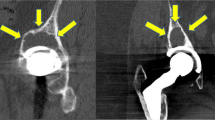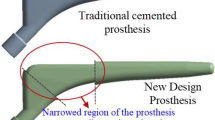Summary
The special conditions contributing to the loosening of 61 hip prostheses were studied and compared with 325 clinical and roentgenologically intact total hip replacements. The loosening rate rose sharply after the 6th postoperative year. One third of the artificial joints examined showed signs of loosening after the 9th year. The average loosening rate was 15.8% after 5.8 years. The condition of the bony bed apparently plays an important role, both qualitatively and quantitatively, in the success of the implant. The operative procedure is of equal importance. Deep fraising of the acetabulum, removal of insufficient amounts of cancellous bone from the proximal femur and inadequate embedding of the prosthesis stem, implantation of the stem in varus, and the use of longneck femoral head prostheses are all factors which increase the risk of loosening. Ultimately, it is the sum of these loosening factors including the biological reaction of the tissue to the biomechanical and biochemically active foreign body which, depending on the period of influence, leads to prosthesis loosening. It is imperative that the patient's lifestyle be adjusted accordingly since external weight-bearing stress also affects durability of the prosthesis.
Zusammenfassung
Im Vergleich mit 325 klinisch und röntgenologisch intakten zementverankerten HüftEndoprothesen werden die besonderen Umstände der Lockerung für 61 Implantate untersucht. Die Lockerungsrate steigt nach dem 6. postoperativen Jahr stark an. Ab dem 9. Jahr erweist sich ein Drittel der untersuchten Kunstgelenke als gelockert. Im Mittel beträgt die Lockerungsrate 15,8% nach 5,8 Jahren. Offensichtlich spielt die Beschaffenheit des Knochenlagers in qualitativer and quantitativer Hinsicht eine entscheidende Rolle. Die operative Technik ist mitentscheidend. Starkes Auffräsen der Pfanne, zu geringe Spongiosaausräumung des proximalen Femur und eine mangelnde Einbettung des Prothesenschaftes, seine varische Implantation and die Verwendung einer Langhalsprothese erhöhen das Lockerungsrisiko. Letztlich ist es die Summe der Lockerungsfaktoren einschließlich der biologischen Reaktion des Gewebes auf den biomechanischen and biochemisch aktiven Fremdkörper, die in Abhängigkeit von der Dauer ihrer Einwirkung zum Versagen der Endoprothese führt. Eine angepaßte Lebensweise ist dringend anzuraten, da auch die äußere Beanspruchung die Haltbarkeit der Endoprothese mit beeinflußt.
Similar content being viewed by others
References
Aldinger G, Gekeler J, Becker N (1979) Vergleich der Hüfttotalendoprothese jüngerer und älterer Patienten. Orthop Prax 12:1015–1017
McBeath AA, Foltz RN (1979) Femoral component loosening after total hip arthroplasty. Clin Orthop Res 141:66–70
Beckenbaugh RD, Ilstrup DM (1978) Total hip arthroplasty. A review of 333 cases with long follow-up. J Bone Jt Surg 60-A:306–313
Diehl K (1975) Knochenbeanspruchung und Knochenumbau bei der Alloarthroplastik des coxalen Femurendes mit Zementverankerung. Arch Orthop Unfall Chir 83:928
Griffith MJ, Seidenstein MK, Williams SD, Charnley J (1978) Eight year result of Charnley arthroplasties of the hip with special reference to the behavior of cement. Clin Orthop Res 137:24–36
Hackenbroch MH, Bruns H, Holbe R, Lechlenthner H (1976) Weitere Erfahrungen mit der Totalendoprothese des Hüftgelenkes. Arch Orthop Unfall Chir 84:149–168
Holz U, Ungethüm M (1975) Klinische und experimentelle Untersuchungen wesentlicher Faktoren bei der dauerhaften Verankerung von Hüfttotalendoprothesen. Arch Orthop Unfall Chir 82:195–204
Huggler AH, Schreiber A (1976) Biomechanik der Implantation. Orthop Prax 6/XII:583–585
Huggler AH, Schreiber A, Dietschi C, Jakob H (1974) Experimentelle Untersuchungen über das Deformationsverhalten des Hüftacetabulums unter Belastung. Z Orthop 112:44–50
Jäger M, Küßwetter W, Rütt G, Ungethüm M, Burkhardt R (1974) Experimentelle Torsionslockerung technisch verschieden implantierter Hüftendoprothesenpfannen. Z Orthop 112:34–44
Kölbel R, Bergmann G (1976) Technische Aspekte der Endoprothetik. Orthop Prax 6/XII:569–577
Kölbel R, Boenick U (1975) Mechanische Eigenschaften der Verbindung von Spongiosa und PMMA. MOT 1:10–12
Mach I (1976) Zur Problematik der Endoprothesenlockerung und -auswechslung am Hüftgelenk. Beitr Orthop Traumatol 23:622–630
Morscher E, Mathys R (1975) Erste Erfahrungen mit einer zementlosen hochelastischen Totalprothese der Hüfte. Z Orthop 113:745–749
Münzenberg KJ (1976) Zur Dauerhaftigkeit der ZementKnochen-Verbindung. Orthop Prax 12/XII:1092–1094
Münzenberg KJ, Dennert R (1975) Pfannenlockerung bei Hüfttotalendoprothesen infolge altersabhängigen Knochensubstanzverlust. Z Orthop 113:947–951
Obertaler W, Bauer R, Sattler K (1980) Results of arthroplasty of the hip joint. Arch Orthop Traumat Surg 96:247–258
Olsson SS, Jernberger A, Tryggö D (1979) Total hip replacement by Müller-Charnley Prosthesis. Acta Orthop Scand 50:457–463
Preston ET (1978) Total hip arthroplasty: a review of four-years experience. Clin Orthop Res 137:48–50
Reichelt A, Riede K (1977) Ursachen isolierter Pfannenlockerung nach Implantation von Hüftgelenkstotalendoprothesen. Orthop Praxis 1/XIII:15–19
Ritter G, Grünert A (1973) Experimentelle Untersuchungen zu den mechanischen Eigenschaften des Knochens im Hinblick auf die Druckosteosynthese. Arch Orthop Unfall Chir 75:302–316
Ritter G, Grünert A, Schweikert C-H (1973) Biomechanische Ursachen von Lockerung und Bruch der Hüftendoprothesen. Arch Orthop Unfall Chir 77:154–164
Schellmann WD, Erdmann H, Klemm K (1974) Zur Frage der Kontraindikation beim alloplastischen Hüftgelenksersatz. Arch Orthop Unfall Chir 80:257–263
Schulitz KP, Dustmann HO (1976) Komplikationen der Totalendoprothese. Arch Orthop Unfall Chir 85:33–50
Singh M, Nagrath AR, Maini PS (1970) Changes in trabecular pattern of the upper end of the femur as an index of osteoporosis. J Bone Jt Surg 52-A:457–467
Swanson SAV, Freemann MAR (1979) Die wissenschaftlichen Grundlagen des Gelenkersatzes. Springer, Berlin Heidelberg New York
Träger KH (1977) Zum Problem der Pfannenauslockerung bei der Totalendoprothese der Hüfte. Arch Orthop Unfall Chir 87:39–49
Willert HG, Semlitsch M, Buchhorn G, Kriete U (1978) Materialverschleiß und Gewebereaktion bei künstlichen Gelenken. Orthopäde 7:62–83
Author information
Authors and Affiliations
Rights and permissions
About this article
Cite this article
Aldinger, G., Gekeler, J. Aseptic loosening of cement-anchored total hip replacements. Arch. Orth. Traum. Surg. 100, 19–25 (1982). https://doi.org/10.1007/BF00381538
Received:
Issue Date:
DOI: https://doi.org/10.1007/BF00381538




